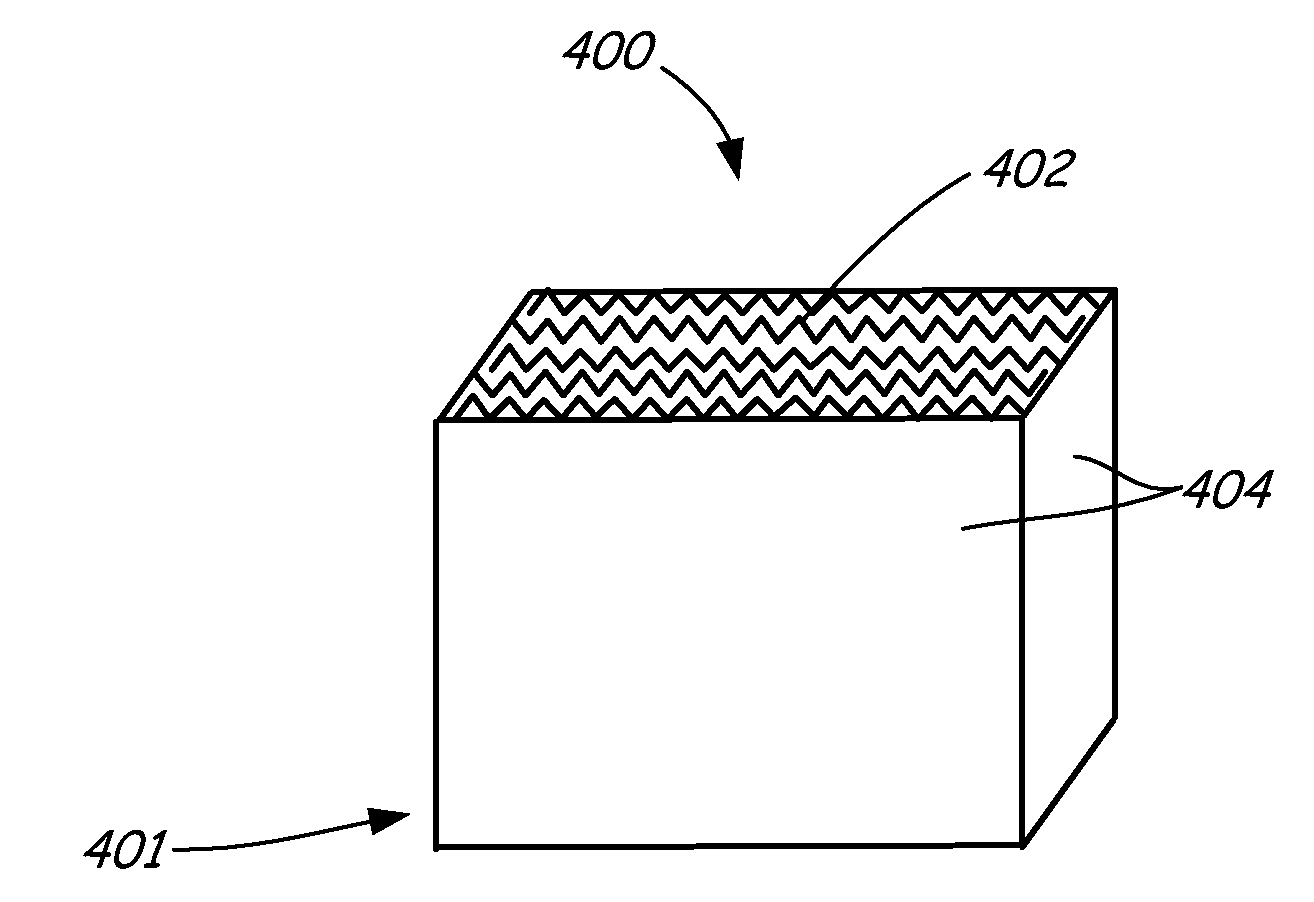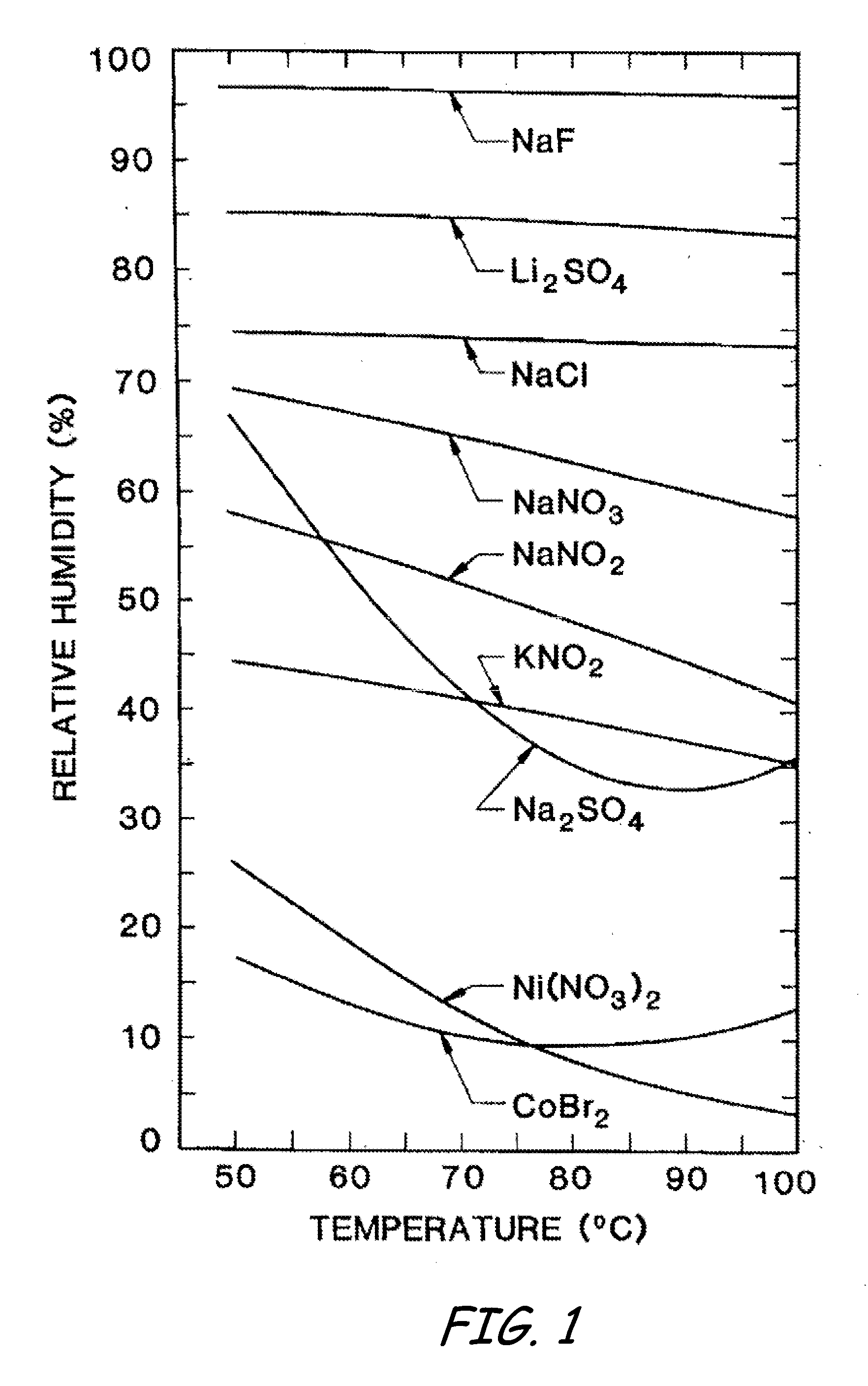Method and Device for Controlling Relative Humidity in an Enclosure
a technology of relative humidity and enclosure, which is applied in the direction of reducing carrier contamination, other chemical processes, separation processes, etc., can solve the problems of excessive disc wear, low moisture level, and high moisture content of memory media
- Summary
- Abstract
- Description
- Claims
- Application Information
AI Technical Summary
Benefits of technology
Problems solved by technology
Method used
Image
Examples
example 1
[0069]40 mL of a 0.4 g / mL CaCl2 (anhydrous weight) solution was added to 16.0 g of SOIL MOIST™ crosslinked polyacrylamide (JRM Chemical, Inc., Cleveland, Ohio) (ground and sieved to 25-50 mesh) with rapid stirring. After about 5 minutes of stirring the fluffy white solid was dried at 120°-130° C. overnight. It was then ground to a course powder in a mortar and pestle, which was immediately placed in a sealed glass jar for storage.
[0070]The water adsorption and desorption isotherm was run in the VTI SGA-100 isotherm instrument (VTI a TA Instruments Company, Hialeah, Fla.) to give the curve shown in FIG. 8. As seen in FIG. 8, the desiccant did not adsorb significant water until the RH exceeded about 18% and that at 90% RH it adsorbed over 340 wt % water.
example 2
[0071]40 mL of a 0.4 g / mL CaCl2 solution (anhydrous weight) was added to 16g of LIQUIBLOCK™ 40F potassium salt of crosslinked polyacrylic acid / polyacrylamide copolymer (Emerging Technologies, Inc. Greensboro, N.C.) (ground and sieved to 25-50 mesh) with rapid stirring. After about 5 minutes of stirring the fluffy white solid was dried at about 135° C. overnight. It was then ground to a course powder in a mortar and pestle, which was immediately placed in a sealed glass jar for storage.
[0072]About 0.5 g of the powder prepared above was placed in a polycarbonate box (0.8 in×0.3 in×0.3 in) that was hand sealed with a PTFE membrane, then dried overnight at about 120° C. One box was placed in two identical 3.5 inch desktop disc drives (internal volume of about 110 mL) that also included about 0.11 g of activated carbon. For comparison, two identical 3.5 inch desktop disc drives containing only about 0.11 g of activated carbon was also monitored. The two drives were placed in a chamber be...
example 3
[0075]About 0.5 g each of the desiccant prepared in Example 2 (CaCl2 and LIQUIBLOCK™ 40F) was placed in were placed in boxes as described above in Example 2. The boxes were then placed in identical 3.5 inch desktop disc drives that also included about 0.11 g activated carbon. For comparison, two identical 3.5 inch desktop disc drives that included only the activated carbon were also monitored.
[0076]The four drives were placed in a chamber being held at 60° C. and 80% RH. The internal RH of the drives was measured using a Honeywell Model HIH 3602 humidity sensor (Honeywell Microswitch Division, 11 West Spring Street, Freport, Ill. 61032), which was mounted in each drive, over the course of 14 days. FIG. 10 shows the trace of the temperature in the chamber (Ch Temp), the relative humidity in the chamber (Ch RH(%)), the relative humidity in the drives with only the activated carbon (C #1 and #2 C) and the relative humidity in the drives with the desiccant of Example 2 and activated car...
PUM
| Property | Measurement | Unit |
|---|---|---|
| volume | aaaaa | aaaaa |
| temperature | aaaaa | aaaaa |
| volume | aaaaa | aaaaa |
Abstract
Description
Claims
Application Information
 Login to View More
Login to View More - R&D
- Intellectual Property
- Life Sciences
- Materials
- Tech Scout
- Unparalleled Data Quality
- Higher Quality Content
- 60% Fewer Hallucinations
Browse by: Latest US Patents, China's latest patents, Technical Efficacy Thesaurus, Application Domain, Technology Topic, Popular Technical Reports.
© 2025 PatSnap. All rights reserved.Legal|Privacy policy|Modern Slavery Act Transparency Statement|Sitemap|About US| Contact US: help@patsnap.com



